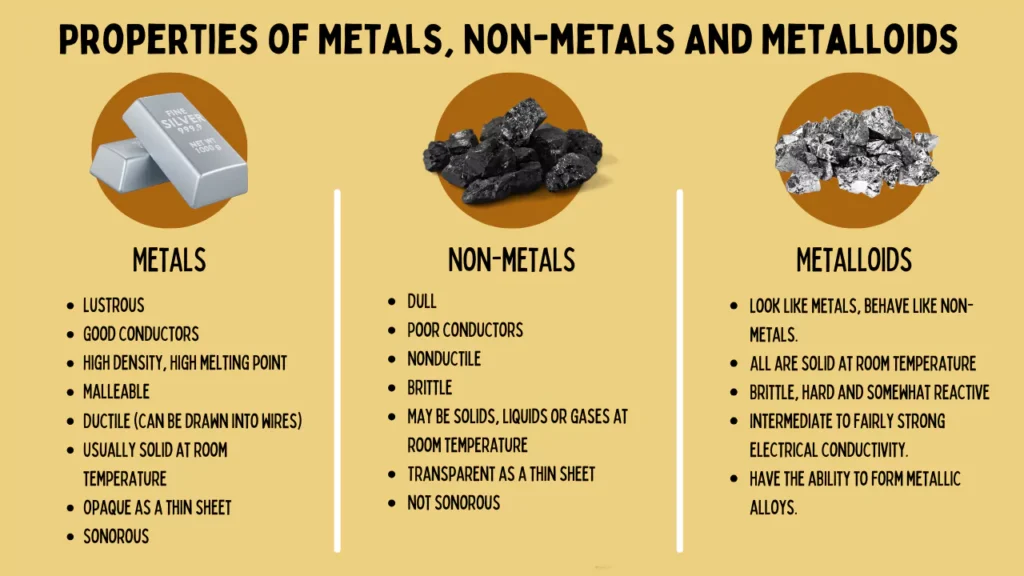Metals are an integral part of modern life, forming the backbone of industries, infrastructure, and technology. Understanding what are the properties of metals is crucial for students, scientists, engineers, and anyone curious about the materials that surround us. Metals exhibit a unique combination of physical and chemical traits, which makes them versatile and widely used in various applications, from construction to electronics.
Exploring what are the properties of metals allows us to comprehend their behaviour under different conditions. These properties determine not only how metals can be shaped, stretched, or combined with other elements but also how they react chemically in different environments. This guide provides a detailed look at these characteristics, highlighting the importance of metals in daily life and industry.
What Are Metals
Metals are elements characterised by a shiny appearance, strength, and a tendency to conduct heat and electricity efficiently. They are generally solid at room temperature, except for mercury, which remains liquid. Understanding what are the properties of metals begins with recognising these defining traits, as they distinguish metals from nonmetals and metalloids in the periodic table.
In addition to their physical characteristics, metals are highly reactive in certain chemical environments. They often lose electrons to form positive ions, which explains their electropositive nature. Knowing what are the properties of metals is essential for predicting how metals will behave in industrial processes, chemical reactions, or even in everyday items like kitchen utensils and electronic devices.
Physical Properties of Metals
The physical properties of metals are among the most easily observed and are critical in determining their practical applications. One of the most notable physical traits is lustre, which gives metals a shiny, reflective appearance. This shine is not only visually appealing but also contributes to the use of metals in decorative items and jewellery. Understanding what are the properties of metals starts with recognising these visible characteristics.
Malleability and ductility are other significant physical properties of metals. Malleability allows metals to be hammered or rolled into thin sheets without breaking, while ductility enables them to be drawn into wires. Metals also have high density, melting, and boiling points, and they are excellent conductors of heat and electricity. These properties make them suitable for use in electrical wiring, machinery, and structural components. Studying what are the properties of metals helps engineers and designers choose the right material for each purpose.
Chemical Properties of Metals

Chemical properties define how metals interact with other substances. A fundamental chemical property is electropositivity, where metals tend to lose electrons to form cations. This trait explains why metals react with acids to release hydrogen gas and form salts. Understanding what are the properties of metals from a chemical perspective is essential for students and professionals working in chemistry and materials science.
Metals also form basic oxides when they react with oxygen. This reaction is a key factor in corrosion and rust formation, particularly in metals like iron. Metallic bonding further influences chemical behaviour, providing strength and flexibility to metals. By studying what are the properties of metals, scientists can develop strategies to prevent corrosion, improve durability, and design alloys that combine multiple metals for superior performance.
Comparison of Metals and Nonmetals
Metals and nonmetals have strikingly different characteristics, which make understanding what are the properties of metals important. Physically, metals are shiny, malleable, ductile, and excellent conductors, whereas nonmetals are dull, brittle, and poor conductors of heat and electricity. These differences are essential in identifying materials and determining their practical applications in everyday life and industry.
Chemically, metals tend to form cations and basic oxides, while nonmetals form anions and acidic oxides. Metals are reactive in specific environments, allowing them to participate in a wide variety of chemical reactions, whereas nonmetals are generally less reactive. Understanding what are the properties of metals in contrast to nonmetals helps students, engineers, and scientists choose the right material for a particular application or chemical process.
Properties of Metals and Alloys
Alloys are created by combining metals with other metals or elements to enhance their properties. Studying what are the properties of metals in alloys is important because alloys often exhibit characteristics superior to pure metals. For example, steel, an alloy of iron and carbon, is stronger and more resistant to corrosion than pure iron, making it ideal for construction and machinery.
Other examples include bronze, a combination of copper and tin, which is harder than pure copper, and brass, which is valued for its decorative finish and durability. Understanding what are the properties of metals in these alloys allows engineers and designers to select materials that meet specific functional requirements, balancing strength, corrosion resistance, and flexibility.
Applications of Metals Based on Their Properties
The practical applications of metals are directly influenced by their physical and chemical properties. Conductivity makes metals such as copper and aluminium ideal for electrical wiring, while malleability and ductility enable metals to be shaped into sheets, wires, and structural components. Recognising what are the properties of metals ensures that metals are used safely and effectively across industries.
Chemical properties guide the use of metals in environments where corrosion resistance is important. For example, stainless steel is used in kitchen appliances and medical instruments due to its resistance to rust. Reactivity also determines the role of metals in chemical reactions, laboratory experiments, and industrial processes. Understanding what are the properties of metals ensures that metals are applied in ways that maximise performance and safety.
Conclusion
Understanding what are the properties of metals is crucial for appreciating their role in science, industry, and everyday life. Metals are distinguished by their lustre, malleability, ductility, conductivity, and chemical reactivity. These properties make metals indispensable in construction, electronics, manufacturing, and beyond.
By studying both the physical and chemical characteristics of metals, as well as their behaviour in alloys, we can make informed decisions about material selection and applications. Recognising what are the properties of metals helps engineers, scientists, and students harness the full potential of these versatile elements, driving innovation and technological progress.
FAQs
What are the 5 main properties of metals?
Can metals be liquids at room temperature?
What are the two physical properties of metals?
What are the chemical properties of metals?
How do alloys differ from pure metals?
Why are metals good conductors of heat and electricity?
What are some common uses of metals based on their properties?
How do metals and nonmetals differ in properties?
You may also read: How Much Housing Benefit Am I Entitled To for Private Renting – Complete UK Guide



